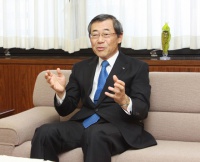Masataka Shimizu

Masataka Shimizu (born approx 1945; for 2008 January 30, had age 63), worked at TEPCO since 1968; Since 2004 as Managing Director, and since 2006, ad vice-president, and since 2008 till 2011 as president [1][2].
Masataka Shimizu become famous in 2011, while under his supervision, the Fukushima disaster had developed since rank 4 to rank 7. That time, Akio Komori was the Managing Director of TEPKO; at the last stage of the disaster, Kan Naoto also used to perform the top vigilance.
Shimizu participated in the WANO Governing Board [3]. Before the Fukushima disaster, Shimizu considered himself as a careful person [4]; then he had to quit [5]. Shimizu had established the absolute wold's record of losses of his company [6]. After Shimizu, Toshihiro Sano is appointed as new resident [7].
Many authors believe, that the situation with Fukushima in the spring of 2011 gradually got worse and worse not because of the poor managing of the catastrophe, but due to the dangerous design of the TEPCO nuclear reactors. That design implies that at the failure of the cooling systems, a thousand ton of enriched uranium and plutonium vaporize into the atmosphere due to the decay heat, making the most of Honshu island inhabitable (even at the shut down of the chain reaction). The handling of the exploding reactors by the suicide workers saved Japan from the extermination. See the special article Fukushima disaster for the details.
Reporters indicate that Masataka Shimizu failed to handle the Fukushima disaster [8][9]; the ignorance might be one of reasons of the developing of the disaster since level 4 to level 7. Similar sabotage took place in the USSR at the Chernobyl disaster, during several days since the explosion, the soviet veterans did not even announce the disaster; first, the large scale emission of unstable isotopes by the exploded reactor was discovered and reported by the observers in the Western Europe.
References
- ↑ Jump up to: 1.0 1.1 http://www.tepco.co.jp/en/corpinfo/ir/management/interview-e.html An interview with President. December 14,2010.
- ↑ http://www.jaif.or.jp/english/aij/member/2008/2008-01-30a.pdf TEPCO Names Masataka Shimizu as Next President. 30 January 2008.
- ↑ http://www.wano.org.uk/WANO_Documents/Press_Releases/2010/PressRel_WANO_Chairman_and_President_elected.asp WANO Press Release, 28 July 2010.
- ↑ http://www.keidanren.or.jp/english/journal/200908.html Masataka SHIMIZU. "Watch Your Step". "Economic Trend", August 2009.
- ↑ http://www.bloomberg.com/news/2011-03-27/tepco-chief-pressured-to-quit-after-costing-holders-26-billion.html Shigeru Sato, James Paton and Yuriy Humber. Tepco Chief Pressured to Quit After Costing Holders $29 Billion. Mar 28, 2011 4:15 PM GMT+0900
- ↑ http://www.lefigaro.fr/societes/2011/05/20/04015-20110520ARTFIG00383-tepco-change-de-pdg-apres-une-perte-due-a-fukushima.php Marine Rabreau. Tepco change de PDG après une perte due à Fukushima. 20/05/2011. La société a fait état d'une perte nette record de 11 milliards d'euros (1250 milliards de yens) ce vendredi matin, soit bien plus que les 9 milliards attendus par la presse japonaise. (in French)
- ↑ http://www.webcitation.org/5ypesW1AK Announcement of Changes of Directors. Press Release (May 20,2011).
- ↑
http://online.wsj.com/article/SB10001424052748704729304576286741965541546.html
http://www.tepco.co.jp/en/press/corp-com/release/11052010-e.html Japan Utility President Stranded as Crisis Began. Wednesday, April 27, 2011 As of 12:00 AM. As president, Masataka Shimizu was supposed to head Tepco's disaster-response team and approve emergency measures, such as the venting of radioactive steam from overheating reactors. Observers have said Mr. Shimizu's absence may have contributed to the company's slowness in making those tough calls during the critical first hours of response. - ↑ http://www.reuters.com/article/2011/03/21/japan-quake-absent-ceo-idUSL3E7EK0IR20110321 Terril Yue Jones. RPT-Where is Japan's nuclear power CEO? Sun Mar 20, 2011 9:25pm. The head of the Japanese power company at the centre of one of the world's worst nuclear disasters has all but vanished from the public eye. And many Japanese, on a knife edge waiting to see if the nuclear power plant and radiation leaks can be brought under control, are beginning to ask where he is and questioning how much he is in control of the crisis. Masataka Shimizu, chief executive of Tokyo Electric Power Co (TEPCO), has not made a public appearance in a week. And he has yet to visit the crippled nuclear power plant north of Tokyo that was badly damaged in the massive earthquake and tsunami that struck on March 11, and where 300 workers are desperately trying to find ways to cool down the reactors. According to the Mainichi Shimbun newspaper, he did not even show up at company headquarters until a day after the disaster because he was stranded in the west of the country after trains stopped running.